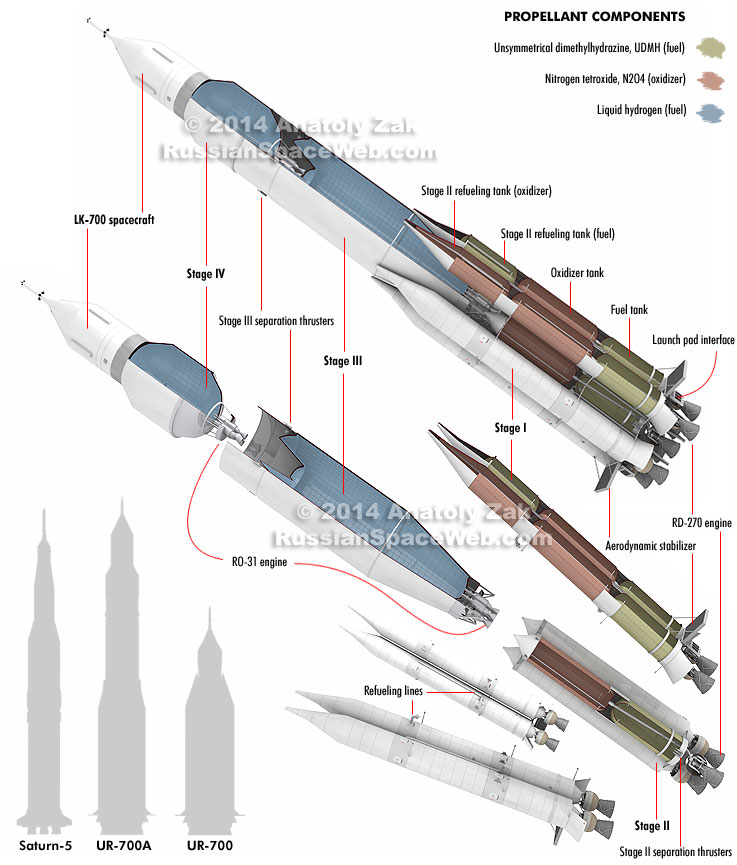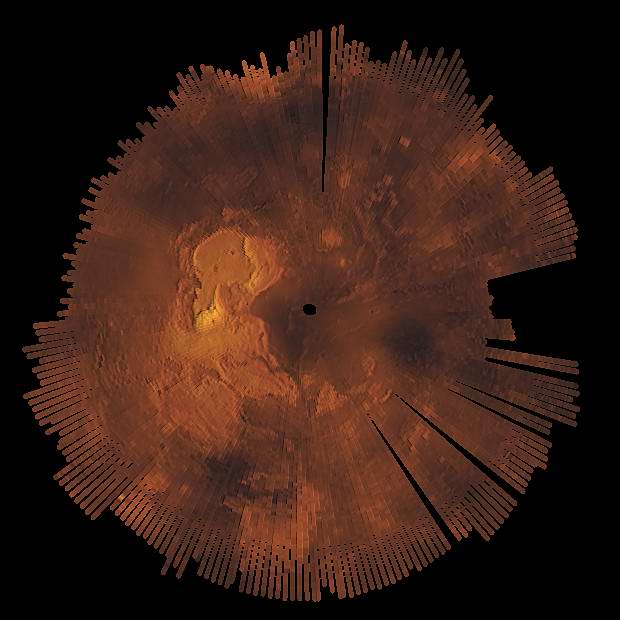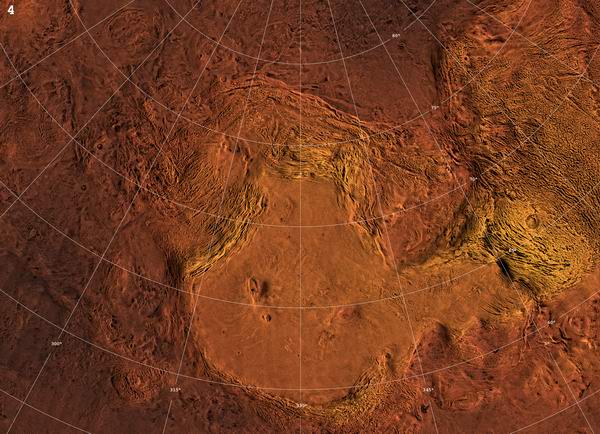
During the 1960s, the prolific Soviet space designer Vladimir Chelomei led the development of the giant UR-700 rocket. It was conceived as a modular alternative to the "single-body" N1 booster, which was favored by the Soviet leadership for the politically urgent goal of landing a man on the Moon ahead of the US. However the N1 project masterminded by Sergei Korolev at the end of the 1950s, ran into numerous technical problems, not last of which, was the need to build the giant vehicle at the remote launch site in Baikonur in the midst of the Kazakh steppe and to develop a complex multi-engine propulsion system.
By the end of 1967, the Kremlin gave the green light to Vladimir Chelomei to work on the preliminary design of the UR-700 rocket as a backup to the troubled N1. Unlike the N1, Chelomei's rocket would be assembled out of components built in Moscow and transportable by rail. Even more importantly, it would use just 12 engines on its three stages, instead of 42 on the boosters stages of the N1. Finally, the UR-700 could launch 151 tons of payload versus 97 tons carried by the N1 and 127 tons delivered by the American Saturn-5.
In parallel with the development of the UR-700, Chelomei's engineers drafted a much bigger follow-on vehicle. Known as Skhema "A" (or Configuration "A", where "A" stood for "atomic"), an even more colossal rocket would use a yet-to-be-developed nuclear engine to increase its payload to an unprecedented 250 tons. (658)
The first two stages of the "A" variant would be borrowed largely unchanged from the original UR-700. On both versions, the six boosters of the first stage would feed their own engines and, simultaneously, refuel the three boosters of the second stage. As a result, the second stage would have full tanks when it took over the powered ascent after the separation of the first stage.
In the meantime, the third and fourth stages of the "atomic" version of UR-700 would be developed from scratch and equipped with the revolutionary RO-31 nuclear engines (a.k.a. RD-0411) burning either cryogenic liquid hydrogen or liquid methane and developing a thrust of 40 tons. Seven such engines would be installed on the third stage and three would propel the fourth stage.
The third stage could have the job of sending a spacecraft on an escape trajectory from the Earth orbit and the fourth could conduct a braking maneuver near the Moon or Mars. The design work on the RO-31 engine was initiated at the KBKhA design bureau in the city of Voronezh in 1964. (717) On Oct. 26, 1965, the Soviet government issued a decree No. 842-304 giving a green light to the development of a small-scale prototype of a nuclear rocket engine known as RD-0410. (718) It was expected to propel an upper stage of the Proton rocket, launching future planetary probes into deep space. (156)
The atomic version of the UR-700 rocket was apparently expected to carry a manned spacecraft on a direct flight to the Moon with a crew reaching seven people. In addition, modules of the lunar base and components of a Martian expeditionary complex could also be launched. Finally, a single such rocket would be enough to launch a manned spacecraft to fly by Mars or Venus. (400)
Chelomei signed the completed preliminary design of the UR-700, (which apparently included a proposal for the "atomic" version), on Sept. 30, 1968. However the full-scale development of the UR-700 rocket was never funded as all the money and efforts were committed to making the N1 fly in the last leg of the race to the Moon.
UR-700M: The biggest rocket ever conceived?
However Chelomei apparently saw an even bigger chance for a follow-on to UR-700 within a year after the cancellation of the project. With the loss of the Moon Race to the US in 1969, Soviet politicians and engineers alike thought of a new frontier in the Space Race. One option would be to beat NASA to Mars!
By 1970, Chelomei's team asked the Moscow-based KBOM design bureau specialized in launch equipment to draft a launching pad that would be at the absolute limit of conceivable size. The facility had to accommodate the 16,000-ton colossus dubbed UR-700M capable of orbiting 750 tons of cargo. The three-stage vehicle would develop 23,400 tons of thrust at liftoff and launch the MK-700 Martian expeditionary complex in a single shot. The spacecraft was named Aelita after a famous Russian post-revolutionary sci-fi novel by Alexei Tolstoy.
In 1971, KBOM also fulfilled orders for launch pad designs for a two-stage version of the UR-700M rocket, which would probably be enough to orbit a giant manned outpost around the Earth.
To handle such a giant vehicle at the launch site, KBOM engineers had to abandon all accepted architectural principles of the Soviet rocketry, according to which a fully assembled space booster is transported in horizontal position and then erected onto its launch pad. Now, they had to adopt an American approach, delivering the rocket to the pad in vertical position. Moreover, the spacecraft would be transported separately and integrated with the rocket on the launch pad.
After considering three possible designs of the launch pad, the one involving a partially buried launch platform was adopted, probably in order to reduce associated wind pressure on the towering vehicle. Even more amazingly, Chelomei requested a provision for a simultaneous assembly of three such rockets at three individual launch pads. (112) More than 40 years after it has been conceived, the design of the monstrous vehicle still remains a mystery.
(More to come!)



 ...
... Big_Gazza
Big_Gazza










